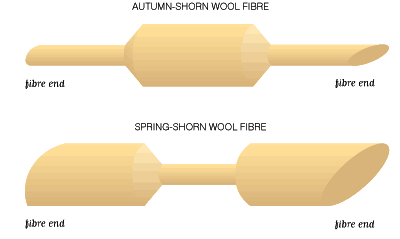IF WOOL is to compete effectively with synthetics and cotton it must meet the market requirements. A recent Woolmark Company survey revealed that consumers want fabrics which are convenient, casual, cost effective, clean and comfortable. CRC researchers at CSIRO Wool Technology are tackling the comfort issue head-on. Their work has revealed that the skin comfort factor (prickle) of wool fabrics is largely determined by the bending characteristics of the fibre ends. Dr Geoff Naylor, the leader of the comfort project says, ‘these bending characteristics are a function of the fibre diameter over the last 1mm or so of the fibre’. It follows that anything that reduces the diameter of fibre ends in the fabric will improve the comfort.
While breeding sheep with reduced mean diameter is one way of achieving this, the CSIRO researchers have identified another approach which can have immediate effect. ‘By simply changing the time of shearing in the highly seasonal Mediterranean environment we can reduce the effective mean fibre diameter by as much as 2 microns’, says Geoff Naylor. This can best be explained by looking at the profile of fibre diameter along the fibre, as shown schematically in figure 1 below.

Figure 1
Effect of time of shearing in the fibre
diameter profile of wools from Western Australia
Clearly after shearing the Autumn-shorn wools have finer fabric ends. However, during processing many fibres are broken, giving rise to new fibre ends. Dr Kerry Hansford, Jane Sambell and Dr Geoff Naylor of CSIRO Wool Technology studied the fibre ends after processing. They examined a large number of Western Australian fleeces covering a range of shearing times. Sample ‘tops’ were made from these fleeces and the fibre end diameter characteristics related to the raw wool measurements.
The following conclusions were made about the fibre ends in the processed top:
- Autumn shearing produced fibre ends 2µm finer than Spring shearing.
- Autumn shearing of Western Australian wools produced fibre ends 1µm finer than Eastern States’ wools.
- Autumn shearing reduced the number of fibres > 30µm
In this issue of The Wool Press: